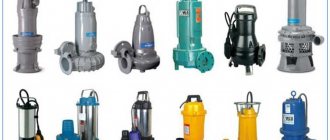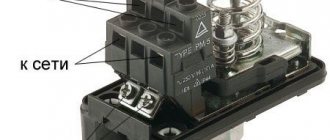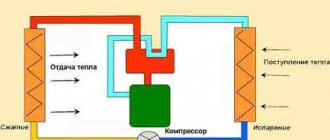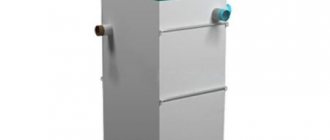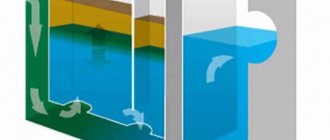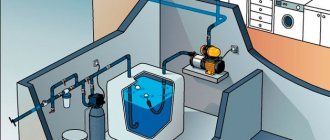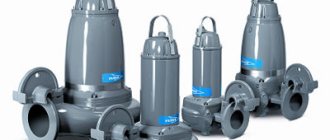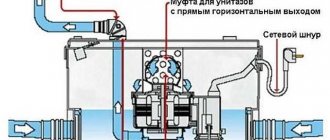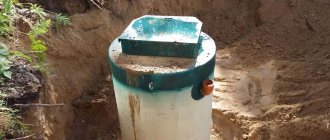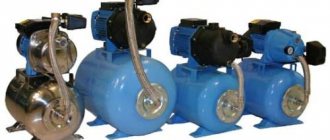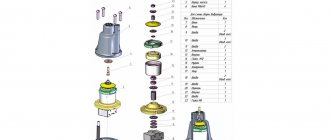You've probably heard that forced sewerage is a solution for difficult situations related to drains in the house. In this article we will look at what this unit is: its operating principle, features, functionality, connection and installation, as well as which pump to choose. First things first.
A conventional drainage system works on the principle of moving wastewater under the influence of gravity. However, if the house is located on a slope or in a lowland, standard designs do not work. In such cases, forced sewerage is used, which is more expensive, but does not have the disadvantages of gravity systems. Take a closer look at its design.
Operating principle and device
Installing a sanitary pump for forced sewerage makes it possible to install bathrooms in any convenient place, including basements located an order of magnitude lower than the general drain.
The presence of such a device
ensures forced discharge of waste matter, including fecal matter , even in cases where the latrine is moved or installed in premises not intended for these purposes.
At the same time, the installation of this device does not at all affect the aesthetics of the room , since it is quite compact and does not catch the eye at all.
Forced-type sanitary equipment is designed for grinding and pumping fecal matter . The principle of its operation is similar to a drainage device, but, unlike it, a sanitary sololift is designed for drains of a larger caliber.
This small compact device allows you to pump wastewater horizontally up to 100 m, and in height - up to 7 meters .
Externally, the fecal pump is a small plastic tank equipped with a grinding mechanism and fasteners. Depending on the model and its purpose, the device can be attached to a sink, toilet, bathtub, washing machine or dishwasher, or shower stall.
To select the correct model, you need to have the following data:
- drain pipe diameter;
- the length of the distance that the drainage masses have to overcome;
- productivity (volume of liquid pumped in 1 hour).
Liquid waste, entering the device’s reservoir, is crushed by the rotating blades of the mechanism . The engine starts automatically as soon as the float rises with the water level to the switch. Using a centrifugal mechanism, the liquid is pumped into a centralized sewer drain.
Forced-type sanitary equipment is divided into three groups:
- submersible;
- semi-submersible;
- outer.
Household sewer pumps are not complicated, but useful equipment. What to look for when purchasing? Read about the benefits of a sewer pump with a grinder for the kitchen here.
We will tell you how to choose and use a toilet pump with a grinder for forced sewage in this article.
Manufacturers and models
Not many companies produce individual sewerage installations. However, the price range is quite wide. Traditionally, European manufacturers are distinguished by good quality, but high prices. No one will be surprised if we say that Chinese sewage pumps cost less, but their quality is worse. In general, the choice, as usual, is expensive and high quality, or cheaper and...
Forced sewerage installations Grundfos (Grundfos) - Sololift (Sololift)
The well-known manufacturer of plumbing fixtures Grundfos produces Sololift pumps for forced sewerage. At the moment, a modified Sololift2 line has been launched. There are no moving parts in contact with drains. The exception is the chopper, but its drive is also “dry”. This makes repairs less of a hassle. There are several Sololift models for different cases:
Sololift sewer pumps are not the cheapest equipment, but they work reliably and meet the stated characteristics. The company also supports warranty repairs.
Pumps for toilets, bathrooms, kitchens and technical rooms SFA
This company specializes in the production of sanitary pumps. There are several lines to solve different problems and connect various devices:
SFA products work reliably and cost slightly less than Grundfus. You can choose a model for any combination of plumbing fixtures. Overall, the SFA sewage pump is a good option. Equipment installation is standard - place it in any convenient place. There is only one limitation - it is better for the outlet pipeline to start from a vertical section, if there is one on your route. If this is not possible, the length of the horizontal section should be no more than 30 cm.
The height of the vertical section is calculated taking into account that the horizontal section must have a slope towards the inlet of at least 1% (1 cm per 1 meter of pipe).
CompactLift fecal pumps from Aquatik
Toilet pumps Compact Lift are produced by the Chinese company Aquatic. This is a more budget-friendly option for individual sewer installations. They have a low noise level.
At the moment there are only three modifications:
Aquatik provides a warranty on its pumps for bathrooms and toilets for 1 year from the date of sale. Failure to operate (presence of fibrous inclusions in drains) may result in refusal of warranty repair.
Willo sewage pumps
The German company Willo is known for producing reliable devices. Toilet pumps are no exception. Good quality plastic, thick tank walls, reliable pump. The following models are available:
The Willo range of sewer pumping units allows you to solve any problem when it comes to equipping bathrooms and toilet rooms in private homes. For commercial or more intensive use, Willo has other solutions.
Pressure sewage pumps STP (Jemix)
These custom sewer installations are manufactured in China. The price category is average. Reviews, as usual, are different - some are completely satisfied, others categorically dislike it.
So, here are the sewerage pumps Jemix offers:
It differs from those described above in its increased power - some models raise drains by 9 meters. Most of the sewerage pressure pumps described above can lift wastewater up to 4-5 meters. So this is where the Jamicks win. In this parameter they have only one competitor - Sololift Grundfos with its lifting height of 8 meters. But its price category is completely different (as is its quality, for that matter).
Advantages and disadvantages
The main advantage of sanitary equipment is its reliability. Despite the small diameter of the drain pipes (18-40 mm) , the functioning of the discharge occurs without any problems due to the continuous operation of the grinding system.
The reliability of the sololift is determined by the principle of its operation: the drainage masses are carried out under the influence of high pressure, whereas in conventional systems the contents of the pipes are “left to chance.” Therefore, no cases of forced sewerage clogging were registered .
Installation of the device does not require special skills or effort , and the use of narrow plastic sewer pipes is quite economical and easy to install. All elements of forced drainage have a modern design, and if desired, it will not be difficult to hide them in the wall and decorate them with cornices, plinths or tiles.
A sanitary pump is an indispensable thing in a country house, in private houses, in separate buildings (shops, bars, cafes, etc.). The use of a forced drain system is not only convenient to use, but also economically beneficial.
Sewage pumps Sololift Grundfos models and their characteristics
The most popular units used for forced drainage of wastewater into sewers are Grundfos
. The entire line includes five models, each of which has its own technical features.
- This model is not equipped with a cutting mechanism, and therefore is intended for the removal of wastewater that does not contain solid fractions. Can be connected to a shower cabin, washbasin, bathtub or bidet. The most compact and economical model
from the entire Grundfos Sololift range.
SOLOLIFT2 C-3
This model also does not have a grinder, so it cannot be connected to the toilet. A distinctive feature of Sololift2 C-3 is its ability to withstand high temperatures
, and therefore such a pump can be used to organize a forced sewage system in the kitchen - to remove waste from the kitchen sink and dishwasher.
SOLOLIFT2 WC-3 This model can also be built into a forced sewage system for toilets, as it has a built-in grinder. This pump differs from the previous model in that it has 3 input connections, and therefore it can be connected to several plumbing fixtures at the same time.
Thanks to their performance and power, sewage pumps of this type can meet the needs of a small family cafe or restaurant. In addition, they are capable of pumping wastewater through small diameter pipelines (from 32 to 50 mm).
Technical specifications:
- Raising drains by 7 m in height and 70 m horizontally.
- Possibility of working with wastewater at temperatures up to + 75 degrees (for a short period of time). Operating temperature: 35 degrees.
This sewer pump for a kitchen sink costs from 25 thousand rubles.
SFA Saniaccess Pump
The pump is suitable for kitchen and bathroom equipment anywhere, regardless of the location of the stationary sewer system.
Technical specifications:
- Maximum wastewater temperature: up to +75 degrees (short-term).
- Feed height: up to 5 m (horizontally – up to 50 m).
- There is no grinding mechanism.
- Price - 18,500 rubles.
Unipump Sanivort 250
Thanks to the high quality of assembly and reliability of components, the pump is durable and practical. Suitable for use in an apartment or country house.
Its distinctive features:
- The pump housing is made of high quality plastic, easy to clean.
- The presence of two inputs, one of which, with a diameter of 40 mm, is suitable for connecting a shower or sink.
- The presence of a check valve that prevents wastewater from mixing with clean water.
- Thermal protection function of the pump motor.
- The presence of a built-in pressure sensor that allows the device to automatically turn off and turn on if necessary.
Technical specifications:
Capacity: 80 l per minute. Dimensions: 172 x 158 x 339 mm. Maximum head: 5 m vertically and 40 m horizontally. The price of the pump will be about 10,500 rubles.
The typical location of a sewer riser in an apartment often turns out to be not the most convenient for its owners, because the placement of the kitchen and bathroom depends on this; forced sewerage is a way to get rid of this inconvenience. With its help, you can not only organize the disposal of wastewater, bypassing the need for redevelopment (and associated capital construction work), but also install plumbing fixtures in the basement of a private house (when the plumbing is located below the riser, and the drains cannot be discharged by gravity). You can learn how to create such a system from this article.
Recommendations for selection
In cases where the drain in the house is located below the level of the centralized drain, it is advisable to install a forced-type system . This is especially true for cottage houses and basements. In such cases, in addition to the sololift system and pipes, it will be necessary to build a storage well, from which fecal matter will subsequently be pumped into a common riser. In this case, the pumping unit is the main element in such a system.
A sanitary pump for forced pumping is installed in the following cases:
For private houses and cottages, the SANICUBIC installation is ideal, which discharges simultaneously from all drainage devices in the house .
This is a fairly powerful and durable device, equipped with two motors. For installing forced sewerage in an apartment, the SFA SANIPACK system, equipped with a universal connection mechanism, is suitable. It can be successfully connected to all drain points in the house (bathtub, toilet, washing machine, shower box, etc.).
For residential use, the sololift of the SFA system is good - using one mechanism, wastewater is discharged simultaneously from all water systems. Its popularity is due not only to its ease of use and ease of maintenance , but also to its reasonable cost.
The SANIKOM SFA pump is universal for installation in public areas . This unit is resistant to high temperatures and heavy loads, designed for pumping large volumes of wastewater, but not intended for draining aggressive substances.
Sololifts are equipped with a carbon filter, thanks to which unpleasant odors do not penetrate into the room.
Depending on the model, technical characteristics and purpose, sanitary pumps from SFA can cost from 14 thousand to 95 thousand rubles . The GRUNDFOS pump is recommended for pumping wastewater of all degrees of contamination.
How to make a sewer system in a private house, read the following article. For the normal operation of the sewer system, it is extremely important to make accurate calculations. Find out what slope the sewer pipes should have from this material.
Installation
In order to correctly install a sewage pump in an apartment, it is sufficient to follow the recommendations of the instructions. To install forced sewerage, you will need a minimum of tools and the help of a specialist to supply power (if one is not available) to the installation site. There are some features:
- The installation of forced sewerage must provide an air gap between the sololift body and the wall of the room, nearby pipes or plumbing fixtures. One centimeter is enough to prevent vibration from operating equipment from being transmitted. If this condition is not met, then a felt or foam pad or a porous rubber pad can be installed at the point of contact.
- It is advisable to install the sololift on a vibration-absorbing mat, for example, vibroisol.
- If sewerage equipment is installed in a niche, then it must be equipped with a door to allow maintenance.
- Pipes supplying drains from plumbing fixtures must go to the device with a slope of at least 2%.
- Pipe joints are coated with sealants.
- When installing, do not forget to install the check valve.
- Connections of all nodes of the sewer network must be correctly installed and sealed. They can be additionally checked before installing forced sewerage equipment, because the sewage system turns from gravity to pressure.
- If the waste rises upward at the outlet, it is recommended to provide a possible drain at the bottom of the vertical section.
- It is recommended to connect the pump for forced sewerage to a separate machine with an RCD.
- The installation must be grounded; for this, a three-wire socket with a functioning grounding is used.
- Threaded metal clamps must be used for pressure pipe connections.
- It is prohibited to use corrugated pipes for sewerage. For outlets, pipes made of hard plastic or copper are recommended. It is also recommended to use one-piece rigid fittings.
Connection to the system
You can connect the pumping mechanism to the drain system with your own hands, but connecting to electricity will require certain skills.
In forced drainage, the horizontal and vertical arrangement of pipes, their length and ratio are of great importance.
The instructions for use for each model contain a detailed description of this ratio .
So, for example, with a pipeline height of 4 m, the horizontal cannot exceed 10 m, and with a height of 1 m, the length can reach 50 m. It is important to comply with this condition , since the quality of wastewater discharge depends on it.
The following step-by-step installation steps:
- A drain pipe from a siphon or toilet is inserted into the receiver of the pumping unit.
- The reverse side of the device is brought closer to the riser.
- Connect the system to the power supply network, having previously installed a protective relay (RCD).
Installation steps for sololifts of various types and manufacturers differ little from each other. You need to carefully read the instructions and follow their recommendations.
Pump - installation
Sewage equipment is a surface pumping installation for sewer systems, which makes it possible to transport wastewater in the absence of gravity sewerage. A powerful transfer pump is built into a small plastic housing with holes through which plastic pipes are connected. It is capable of pumping waste both horizontally and vertically. Installations are produced without a grinder - for so-called gray waste (from a shower tray, bathtub, washbasin, etc.). And with a grinder - for toilets and sinks.
Typically, toilet paper is processed using shredders. But some modifications are capable of processing more complex waste, such as gaskets. Such information is available in the product passport.
The plastic housing of the modification houses the pump itself, the filter system and the control element. A carbon filter is also inserted into the housing, which should be periodically washed with water. The device for the sewer system has an outlet pipe with a diameter of 100 mm. The pump itself is submerged, which makes its operation silent. A check valve is installed to ensure that waste does not return to its point of origin.
The equipment operates in the following sequence:
- Liquid leaves the plumbing fixture and flows through the inlet into the chamber with the pump. Sewage equipment can have up to 4 inlet openings. Consequently, up to four separate devices are connected to the sololift. However, first, several sources of waste located nearby can be combined and have one common drain pipe.
- A shredder is installed on the same shaft with the pump (in front of it), which destroys solid waste inclusions (food debris, wool or hair, etc.). Processing with a grinder transforms all this into an emulsion state. The chopper and pump axis are made of high-strength stainless steel.
- Next, the sololift passes the wastewater through filters and, using pressure, ensures its transportation through the pipes.
- When all the drains are pumped out, the engine, with input from the control element, turns off and “rests” until the moment when the container is filled and a signal to turn on is received from the level sensor.
Features of operation
The main condition for the full operation of a forced sewer pump is the presence of a centralized water supply .
The artificial sewerage mechanism is easy to maintain . From time to time, the container for collecting waste waste needs to be sanitized. To do this, it is enough to fill the tank with “Belizna” or a specially designed product or liquid for cleaning pipes, which effectively dissolves deposits on pipes and walls.
At the same time , you should refrain from using organic products that can render rubber seals and plastic water pipes unusable.
If the sanitary pump is used in unheated premises, at the beginning of the winter season .
Types of forced sewerage and operating principles
The sololift operates according to one principle - when wastewater enters its tank, a powerful pump is turned on, which transports sewage all the way to the pipe, through which it can move by gravity. There are several models:
- Hot waste pump with grinder. The maximum temperature limit of the liquid is 95 degrees. The universal model copes equally well with both fecal matter and water from the sink, bathtub, and household appliances.
- A pump without a grinder for pumping wastewater with a maximum temperature of 95 degrees. More often it is installed to transport water from the washing machine/dishwasher and shower/bathtub.
- Model for cold drains with cutting elements. Suitable for installation behind the toilet only.
- Cold waste water pump without grinder. The maximum temperature of pumped water is 45 degrees.
The most expensive models are sololifts equipped with cutting elements.
When purchasing a device, you need to carefully read the instructions. Some manufacturers recommend forced drainage for specific plumbing fixtures and prohibit use in other cases.
Weaknesses, main breakdowns and how to prevent them
Since the sololift mechanism operates in an aggressive environment, internal surfaces and parts must have additional protection . This applies to all components, wires and seals.
- The installation of a sololift should be carried out in a secluded but accessible place .
- The blades of the chopper impeller should be pointed - this will help avoid clogging.
- To increase reliability, additional choppers can be installed in front of the impeller .
- When purchasing, you should pay attention to the product labeling : sololifts intended for cold waste water should absolutely not be used in hot water supply.
Perhaps the main disadvantage of sewerage systems of this type is the electrics.
Voltage changes in the network or interruptions in the supply of electricity can lead to a decrease in power, the performance of the entire system, or its automatic shutdown. Engine failure cannot be ruled out for this reason. To protect yourself from such excesses, it is recommended to install a voltage stabilizer in your home. In cases where the house has a general forced drain installation , it is recommended not to overload several drain points at the same time during moments of unstable voltage.
Forced-type sewage pumps for the most part have an unlimited service life , and with careful use they can last for decades.
How does this type of sewer work?
Forced sewerage equipment is most often installed in country houses. Otherwise the system is called sololift.
The equipment for this type of sewage system is a pump with a grinder, which has compact dimensions and is hidden in additional plumbing or in the toilet tank.
The wastewater entering the forced sewage device is pumped out and ground by a grinder. After this, the sewage enters the septic tank or the central sewer pipeline.
The pump with the chopper has high power parameters. This allows him to cope with a wide variety of human waste and remove it in any direction: vertically - five to seven meters, horizontally - one hundred meters
. A vertical outlet is necessary if all plumbing is located below the sewer.
To drain wastewater using forced sewerage equipment, large diameter pipes are not required. The diameter of the pipeline can be from 18 to 40 millimeters.
This allows you to install sololifts yourself.
Forced sewerage can be installed almost anywhere in a private house, since there is no need to take into account how the sewer riser will be located: horizontally or vertically. In addition, with the help of such equipment you can solve the age-old problem of a standard layout, which involves the location of the toilet next to the kitchen.
Nuances when installing a sololift
There are a number of requirements that should be adhered to when installing forced sewerage:
- The sololift is installed on a specially prepared site. At the same time, access to the device must be free in case of repairs and maintenance.
- For the toilet you only need a sololift with a grinder.
- There should be an electrical outlet near the location of the forced sewer system.
- When installing a sololift, you should ensure that, according to the diagram, the inlet pipe to the pump coming from the plumbing equipment is located at a slope towards the device.
When installing forced sewerage, all joints should be sealed with gaskets, which are included in the kit. It would be useful to use a sealant.
How to choose pumping equipment
In order for the device to function correctly over a long period, it is necessary not only to carry out high-quality installation, but also to select the most suitable model in a particular situation.
When choosing a model, it is recommended to adhere to certain rules:
First of all, it is advisable to clarify the power and capacity of the tank of the selected model. It is important that the equipment fully copes with the volume of waste liquid. The optimal value is considered to be 25 cubic meters. m. per hour for a family of 4-6 people;- determine the appropriate pipe diameter; this depends, for example, on the cross-section of the sewer riser and the nature of the drains. The most popular are kitchen pumps with a diameter of 80 mm;
- take into account the degree of adaptation to hot water. This is especially true for situations where apartment owners plan to connect several appliances to one pump at once, including washing machines and dishwashers. When hot water is supplied to a pump designed for cold liquid, it will quickly stop working correctly;
- It is advisable to purchase equipment with a built-in thermal fuse. It automatically turns off the pump when water is supplied at elevated temperatures;
- You should pay attention to the method of connecting the outlet pipes to the body. If there are vertical pipes, the problem does not arise; installation of this model is quite simple. And if the connection is made horizontally, then an additional adapter pipe will be required.
What to look for when choosing?
Before you go shopping for a unit, you need to decide what characteristics the pump should have, how and where it will be used, and what devices will be connected.
- Performance. The most important parameter. It depends on how the device will cope with the tasks assigned to it. For a family of 4 people, a capacity of about 25 cubic meters per hour is sufficient.
- Diameter of connected pipes. This is a matter of compatibility between the pump and household appliances, as well as the sewer system. The fewer adapters you need, the better. It is better to determine the diameter of the drains in advance. Most often, units with an outlet pipe diameter of 80 mm are purchased, since even non-crushed waste passes through such an opening without any problems.
- Temperature regime. It is necessary to decide in advance how the device will be used. If only for washing dishes, fruits and vegetables, then it is not necessary to take a heat-resistant device. However, it is better that the pump has a temperature reserve so that later you can connect a washing machine or dishwasher to it without any problems.
- The type of pipe connection depends on how they are located in the apartment. It is better to avoid unnecessary adapters and connections.
- Availability of shredders. It is better to have them, because when cooking and washing dishes, organic waste will almost certainly get into the pump. If there are no knives, it may become clogged. And it will be worse to cope with your functions.
- How long can the pump run without interruption? This is especially important if you have a large family and it takes a lot of time to wash dishes, or if you have a dishwasher or washing machine connected.
